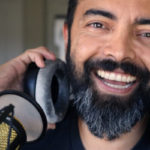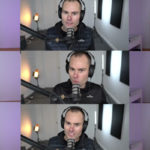Podcast: Download (Duration: 45:56 — 42.8MB)
Get Notified Of Future Episodes Apple Podcasts | Spotify | Amazon Music | Android | Blubrry | Gaana | TuneIn | Deezer | Anghami | RSS | More
YouTube is coming to the forefront of content marketing, and previous guests like Charley Valher have spoken on its importance.
In this episode, James wants to bring a different perspective to the topic. So to speak from the viewpoint of a former data analyst and current traffic educator, he’s brought on TeachTraffic’s Ilana Wechsler.
Ilana will be talking from her experience of building a YouTube audience.
She and James will look at the fundamentals of effective YouTube audience targeting.
And they’ll explore the advantages of combining paid traffic strategies like a brand campaign and dynamic search ads with organic traffic.
Table of contents
1. Realizing YouTube is important
2. The gains that are possible
3. A starting point for building an audience
4. Ilana’s five-step process
-
a. Picking your niche
b. Research
c. Creating a content plan
d. Making the actual videos
e. Titles, descriptions and thumbnails
5. Next: three different search campaigns
6. Why it’s worth getting help
Realizing YouTube is important
Ilana opens by talking about the synergy between organic content and paid advertising on YouTube. She heartily recommends integrating the two for greater impact. People often focus solely, she says, on ads, overlooking the powerful combination of organic and paid content, which together can amplify results significantly.
James has had his own breakthroughs on YouTube. He shares his personal experience as a new-fledged surf influencer, illustrating the power of the platform in building authority and creating opportunities, beyond just paid or organic traffic. His story of recognition and offers from a surfboard manufacturer highlights YouTube’s potential for personal branding and influence, even with a small subscriber base.
Ilana reflects on her YouTube journey, starting from a dormant channel in 2016 to a significant growth in subscribers and business impact, brought about by collaboration with a well-established YouTuber. The experience opened her eyes to the platform’s possibilities for building rapport and authenticity, and led her to focus more on her channel’s growth.
James has learned much from peers and experts in the YouTube community, such as the importance of content quality, keyword research, and storytelling in gaining viewership. He’s enjoyed success with story-based content on his surf channel, proving that even with a modest subscriber count, high-quality content can attract significant views and notice on YouTube.
The gains that are possible
Ilana and James discuss the power of niche-specific YouTube videos.
Despite having, like James, a relatively small channel, Ilana has successfully generated significant revenue from a single video targeted at a very specific audience. She stresses the importance of creating content that addresses the precise needs and pain points of a target audience. This, she says, leads to a compounding business effect, where people needing exactly what she offers discover her and get in touch.
James has a client in e-commerce struggling with high ad costs. He’s suggested to this client joining TeachTraffic.com for expert analysis and optimization of ad campaigns. This could significantly reduce the cost per lead, he believes, offering a substantial return on investment, especially for those spending large amounts on ads.
Ilana sees herself as a “second-opinion doctor” in the digital marketing world, creating over-the-shoulder, technical content tailored to her audience’s needs. Her videos are designed to help viewers learn how to create their own campaigns, appealing to a specific market segment that prefers hands-on learning over hiring an agency.
In the surfing market area, James focuses on discussing equipment rather than showcasing surfing skills. This approach caters to a niche interested in understanding the gear before purchasing, again illustrating the importance of content aligned with audience interests and needs.
A starting point for building an audience
James and Ilana’s strategies for YouTube content creation are influenced by their friend Zac Mason‘s advice on market research and thumbnail testing. James has redesigned his content strategy based on what works in both his sporting and business channels. Ilana, focusing on data-driven insights, is developing a course for TeachTraffic.com, providing a structured approach for those seeking to build a YouTube audience effectively.
Ilana emphasizes starting with the end goal in mind. Her aim is to build an audience interested in learning Google Ads, which she leverages through paid search ads. By connecting her YouTube channel to her Google ad account, she has created a remarketing list of about 60,000 people who have watched her videos, allowing her to target her ideal potential customers accurately.
There are notable differences between building an audience on YouTube versus platforms like Instagram. Ilana points out that YouTube viewers often have higher intent, as they are actively seeking specific information or solutions, unlike the more passive, entertainment-focused audience on Instagram. This difference in audience intent is crucial for content creators to understand, in order to engage and convert their viewers effectively.
Knowing and addressing the specific needs and goals of a target audience ensures that content is not only engaging but also leads to practical results, both for the creators and their viewers.
Ilana’s five-step process
Ilana outlines her five-step process to build a targeted YouTube audience.
-
1 – Picking your niche
It starts with picking a niche. This step, she says, is easy for most people, as they generally know their niche.
James notes Ilana’s expansion into organic traffic as a complement to her paid traffic expertise, highlighting the need to create quality organic content. Ilana clarifies her approach is not about being a YouTube SEO expert but sharing a process that has worked well for her and others in their discussion group.
2 – Research
The second step in Ilana’s process is thorough research, which she says is crucial for content direction. This involves studying competitors, understanding their success, and identifying breakout videos. She also suggests a content brainstorm to identify what the target audience wants to achieve, their pain points, and the subtopics within a niche. James agrees that many people overlook this critical step, essential for intentional content creation.
3 – Creating a content plan
Ilana’s third step involves creating a content plan. She shares a strategy she heard from another expert: creating 100 videos in 100 days to kickstart a channel. While she only reached 63 days in the challenge, this approach led to exponential growth for her channel. The goal is to have numerous small videos that rank in YouTube searches, so the research phase is crucial for identifying topics with the right balance of search volume and competition.
4 – Making the actual videos
The fourth step is about producing the actual videos. Ilana learned through collaboration the importance of structuring videos with a clear introduction, body, and conclusion or call to action. The introduction should be concise and immediately convey the video’s content, while the body must be direct and to the point. She emphasizes keeping audience retention in mind by creating open loops and hooks to keep viewers engaged until the end.
5 – Titles, descriptions and thumbnails
The final step focuses on titles, descriptions, and thumbnails, which are key for attracting viewers. The thumbnail acts as a “scroll stopper,” and Ilana mentions software tools like thumbnailtest.com to optimize click-through rates and viewer retention. She stresses the importance of a compelling title and description that align with the video’s content, reinforcing the vid’s potential to attract and retain the target audience.
Next: three different search campaigns
Once you have a a well-defined audience, Ilana recommends three types of search campaigns to target them on Google Ads.
-
1 – Brand campaign
The first type is a brand campaign, where the aim is to direct traffic to a specific page that the advertiser controls. This approach is useful for capturing brand-related searches and potentially blocking competitors from capitalizing on your brand name.
2 – Top of funnel retargeting search campaign
The second campaign type suggested by Ilana is a top-of-funnel retargeting search campaign. This strategy involves bidding on broader keywords only for a targeted audience that has already shown interest in the topic. For example, in Ilana’s case, she would bid on the term “Google ads” exclusively for individuals already interested in learning about Google ads, avoiding the broader, more general audience.
3 – Dynamic search campaign
The third campaign type Ilana suggests is the dynamic search campaign. In this model, Google determines which keywords to bid on based on the content of the advertiser’s website. This approach helps to uncover what the target audience is searching for, providing valuable insights for keyword discovery and content strategy.
Why it’s worth getting help
So what are the benefits of joining TeachTraffic.com as opposed to figuring out Google Ads on one’s own?
Ilana’s platform will guide users through the process of connecting their Google Ads account to YouTube and targeting specific audiences. This guidance is hugely helpful for navigating the complexities of Google Ads and avoiding common pitfalls, thereby saving time and budget.
James shares how he leverages YouTube content beyond the platform itself. He transcribes videos into blog posts, enriches his website with SEO-friendly content, and interlinks related topics for enhanced organic traffic. Ilana’s approach to paid traffic amplification complements this strategy by targeting a specific, intent-driven audience with its three different types of ad campaigns.
Ilana mentions an unexpected perk from her YouTube efforts: earning revenue from ads on her channel, Teach Traffic. James knows ad revenue is a significant income source for content creators – for some, even, their only income source. He does advise against reliance on a single source of earnings, but believes, in the same boat, he would reinvest ad revenue into other income-generating ventures.
Ilana’s YouTube channel is at YouTube.com/teachtraffic. If you’d like help with your paid ads, she can be found at TeachTraffic.com.
Which of your YouTube thumbnails is a winner? – ThumbnailTest.com
Liked the show? Enjoy all the episodes when you subscribe on iTunes













Leave a Reply